“Mankind will not have peace until it turns with trust to My mercy.”
Jesus. Diary of Saint Faustina, 300.
The Worship of The Divine Mercy is not a devotion among others but it is the heart of every authentic spirituality since it concerns the very essence of the Christian message. It is, therefore, not an optional but a universal and perennial need for Christianity. Together with the accomplishment of the works of mercy, trust in God seems to be the essence of the worship of divine mercy other than the purpose of the worship of the Sacred heart which is the reparation of the sins committed by humanity. If it is true that worship is primarily interior and concerns substantially the three virtues specified by our charism (humility, trust and mercy), however it does not disregard manifestations and external forms that embody the cult itself. The external forms of this cult left by Jesus himself in the revelations made in Santa Faustina are essentially five, which can be understood as five “doors” that give us access and allow us to draw on the Infinite Mercy of God.
- The Sacred Image of Merciful Jesus
- The Feast of Divine Mercy
- The Chaplet to Divine Mercy
- Hour of Mercy (ninth hour)
- The spread of the cult of Divine Mercy
These reflections are taken from the book “The Divine Mercy and Sister Faustina” by father Andrzej Witko.
